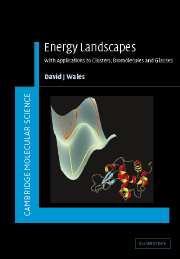Book contents
- Frontmatter
- Contents
- Preface
- 1 Introduction
- 2 The Born–Oppenheimer approximation and normal modes
- 3 Symmetry considerations
- 4 Features of the landscape
- 5 Describing the landscape
- 6 Exploring the landscape
- 7 Properties of the landscape
- 8 Clusters
- 9 Biomolecules
- 10 Glasses and supercooled liquids
- Appendix A Sylvester's law of inertia
- Appendix B Derivation of Ω(E, P, L)
- Index
7 - Properties of the landscape
Published online by Cambridge University Press: 05 October 2013
- Frontmatter
- Contents
- Preface
- 1 Introduction
- 2 The Born–Oppenheimer approximation and normal modes
- 3 Symmetry considerations
- 4 Features of the landscape
- 5 Describing the landscape
- 6 Exploring the landscape
- 7 Properties of the landscape
- 8 Clusters
- 9 Biomolecules
- 10 Glasses and supercooled liquids
- Appendix A Sylvester's law of inertia
- Appendix B Derivation of Ω(E, P, L)
- Index
Summary
In this chapter we consider the calculation of thermodynamic and dynamic properties using stationary points sampled from the PES. In this approach attention is focused on local minima and transition states of the PES, defined as stationary points with zero and one negative Hessian eigenvalues, respectively (Section 4.1), and theories are required for the local densities of states and minimum-to-minimum rate constants, as outlined in Section 7.1.1 and Section 7.2.1. There can be several reasons to employ such techniques. In particular, it may be possible to calculate approximate thermodynamic and dynamic properties much faster than for conventional Monte Carlo or molecular dynamics simulations. For example, the equilibrium between competing structures separated by large potential energy barriers may be difficult to treat even with techniques such as parallel tempering. This situation arises for Lennard-Jones clusters with nonicosahedral global potential energy minima (Section 6.7.1, Section 8.3), where finite size analogues of a solid–solid phase transition can be identified (1–3). Such transitions probably represent the most favourable case for application of the superposition approximation discussed in Section 7.1, because only a few low-lying minima make significant contributions to the partition functions at the temperatures of interest. Some results for these transitions are illustrated in Section 7.1.1.
Dynamical properties have been calculated using databases of minima and transition states using a master equation approach (Section 7.2.2) for a number of different systems (4–28).
- Type
- Chapter
- Information
- Energy LandscapesApplications to Clusters, Biomolecules and Glasses, pp. 364 - 433Publisher: Cambridge University PressPrint publication year: 2004

